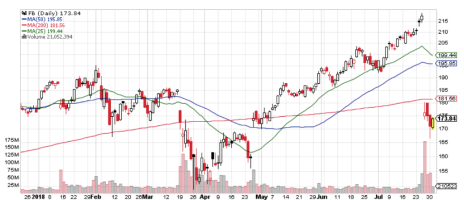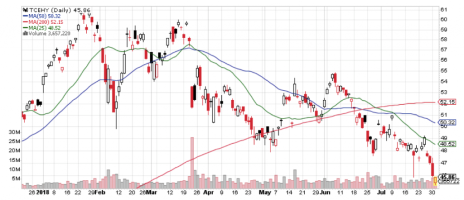Experienced growth investors know that no stock can rally forever. At some point, a bad quarterly report, a challenge from a new competitor, a hiccup in the national economy or a rotation out of a sector will trip up even the strongest of stocks.
How Quickly the Mighty Fall
The most dramatic recent example of a company hitting the sidewalk with its face is undoubtedly Facebook (FB), which traded above 218 on July 25, but at the close on July 26 was priced at 176. That 20% drop wiped out about $120 billion of market capitalization and also tripped up the Nasdaq, which had just hit a new all-time high.
But for those who follow emerging markets, the Facebook debacle, while useful as a cautionary tale, wasn’t really a surprise. EM investors have watched as Tencent Holdings (TCEHY), everyone’s favorite over-the-counter stock, has slipped from its January 26 high of 61 to below 46 on July 31. That’s a slump of nearly 26%, which is a big drop for a company with a market cap of $433 billion. And considering that Tencent’s three most recent quarters have all featured revenue growth of more than 60% and after-tax profit margins in the mid-20% range, and that there’s a rapidly growing roster of institutional investors, it’s downright astonishing.
[text_ad]
(Despite the negative reaction to Facebook’s pessimistic guidance for future growth, its numbers are also very strong, including a string of quarters with revenue growth over 40% that stretches back to Q2 2015 and estimates for earnings growth of 19% this year and 16% in 2019.)
True, FB’s decline has been much more dramatic in its speed. Here’s a daily chart that shows the stock advancing on rising volume ahead of earnings and how quickly the stock fell from its all-time high on July 25. (The red line is the 200-day moving average, which is usually considered the electrified third rail of growth investing.)
The chart for TCEHY is a different matter entirely. The stock’s decline from its January high has been relentless, with five rally attempts that got above its 25-day moving average only to fall to new lows. The stock’s 200-, 50- and 25-day moving averages are reversed from the usual bullish order and the stock is trading at its November 2017 levels. Here’s what the daily chart looks like.
So the big question is whether either of these stocks looks like a good buy after their huge haircuts?
FB vs. TCEHY: Which Is the Better Buy?
That all depends on what you think is a good indicator for a growth stock. Facebook stock now has a P/E ratio of 24, well below its peak, but still not exactly cheap. And TCEHY (whose earnings estimates are for 15% this year and 35% in 2019) trades at a trailing P/E of 41, which is also not a valuation to make a value investor reach for the Buy button.
No, I think the only sane way to approach buying either FB or TCEHY is to wait for the stocks to put in a convincing bottom. And the best way to determine that a stock has bottomed is to watch the chart, waiting until you see evidence that the buyers are beginning to move back in, which is either a stretch of flat trading in a relatively tight range or a double bottom with increasing volume on days when the stock advances.
(Remember the old market maxim, which is usually applied to the major market indexes: If you think it’s a bottom, you’re too early. If you know it’s a bottom, it’s too late. And all that means is that bottoms are only obvious in retrospect, so don’t get antsy about wanting to buy at the stock’s absolute low. Only fiction writers can do that.)
Personally, I think Tencent Holdings stock is likely to be a better buy of the two. Facebook has already signed up such a high percentage of the total population of the Earth, that growth is likely to be increasingly incremental. Meanwhile, Tencent Holdings is leveraging its QQ messaging platform and WeChat social platform to a rapidly expanding audience. And the company is using its firehose of free cash flow to form joint ventures and make strategic alliances with a host of businesses both inside and outside China.
So keep watching those charts. That’s what I’ll be doing. And when I think TCEHY has put in its time in purgatory and is back on the growth road, I’ll let the subscribers to my Cabot Global Stocks Explorer know right away. I’ll do the work and they’ll make the money.
If you’d like to be among those making money in emerging markets without all the legwork, click here.
[author_ad]



